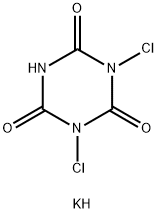Potassium dichloroisocyanurate is a white crys-
talline solid. Chlorine odor.
White, slightly hygroscopic, crystalline
powder or granules. Active ingredient
59% available chlorine; decomposes at 240C.
Useful source of available Cl in solid bleach and detergent formulations.
White solid with an odor of chlorine. Mixes with water.
Water soluble. troclosene potassium may vigorously react with water releasing chlorine gas. Material containing less than 39% available chlorine will undergo reactions as described herein, but may take longer to initiate, and the resulting reaction may not be as vigorous [AAR 1992].
Contact with ammonium compounds or hydrated salts can cause a very vigorous reaction. Prolonged exposure to heat /fire may result in the vigorous decomposition of the material with the rupture of its containers, troclosene potassium will accelerate the burning of combustible materials [AAR 1991]. Chlorine plus alcohols would yield alkyl hypochlorites. They decompose in the cold and explode on exposure to sunlight or heat. Tertiary hypochlorites are less unstable than secondary or primary hypochlorites [NFPA 491 M. 1991].
Moderately toxic by ingestion. Dangerous
fire risk in contact with organic materials. A strong
oxidizing agent.
Dust causes sneezing and coughing; is moderately irritating to the eyes and causes itching and redness of skin. Ingestion causes burns of mouth and stomach.
Moderately toxic by
ingestion, causing ulceration or bleeding
from stomach. A skin and severe eye
irritant. Causes emaciation, weakness,
lethargy, darrhea, weight loss. Autopsy
indicates gastrointestinal tract irritation,
tissue edema, liver and hdney congestion. A
powerful oxidizer. When heated to
decomposition it emits very toxic fumes of
K2O, Cl-, and NOx.
Potassium dichloroisocyanurate is
used in household bleaches, dishwashing compounds and
detergents.
UN2465 Dichloroisocyanuric acid, dry or
Dichloroisocyanuric acid salts, Hazard Class: 5.1; Labels:
5.1-Oxidizer.
A strong oxidizer; violent reaction with
reducing agents; combustibles, organics; easily chlorinated
or oxidized materials; ammonia, urea, other nitrogen com-
pounds; calcium hypochloride; other alkalies and moisture.
Contact with ammonium compounds or hydrated salts can
cause a very vigorous reaction. Prolonged exposure to heat/
fire may result in the vigorous decomposition of the mate-
rial with the rupture of its containers, it will accelerate the
burning of combustible materials. Chlorine plus alcohols
would yield alkyl hypochlorites. They decompose in the cold and explode on exposure to sunlight or heat. Tertiary
hypochlorites are less unstable than secondary or primary
hypochlorites .

